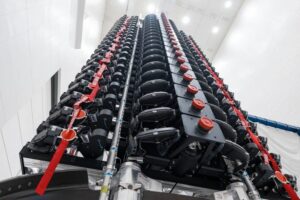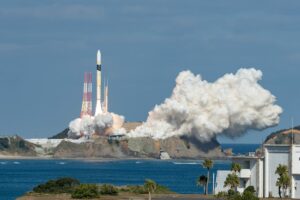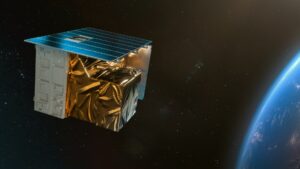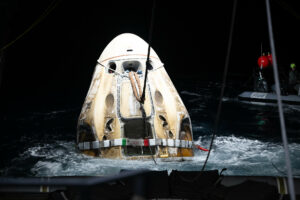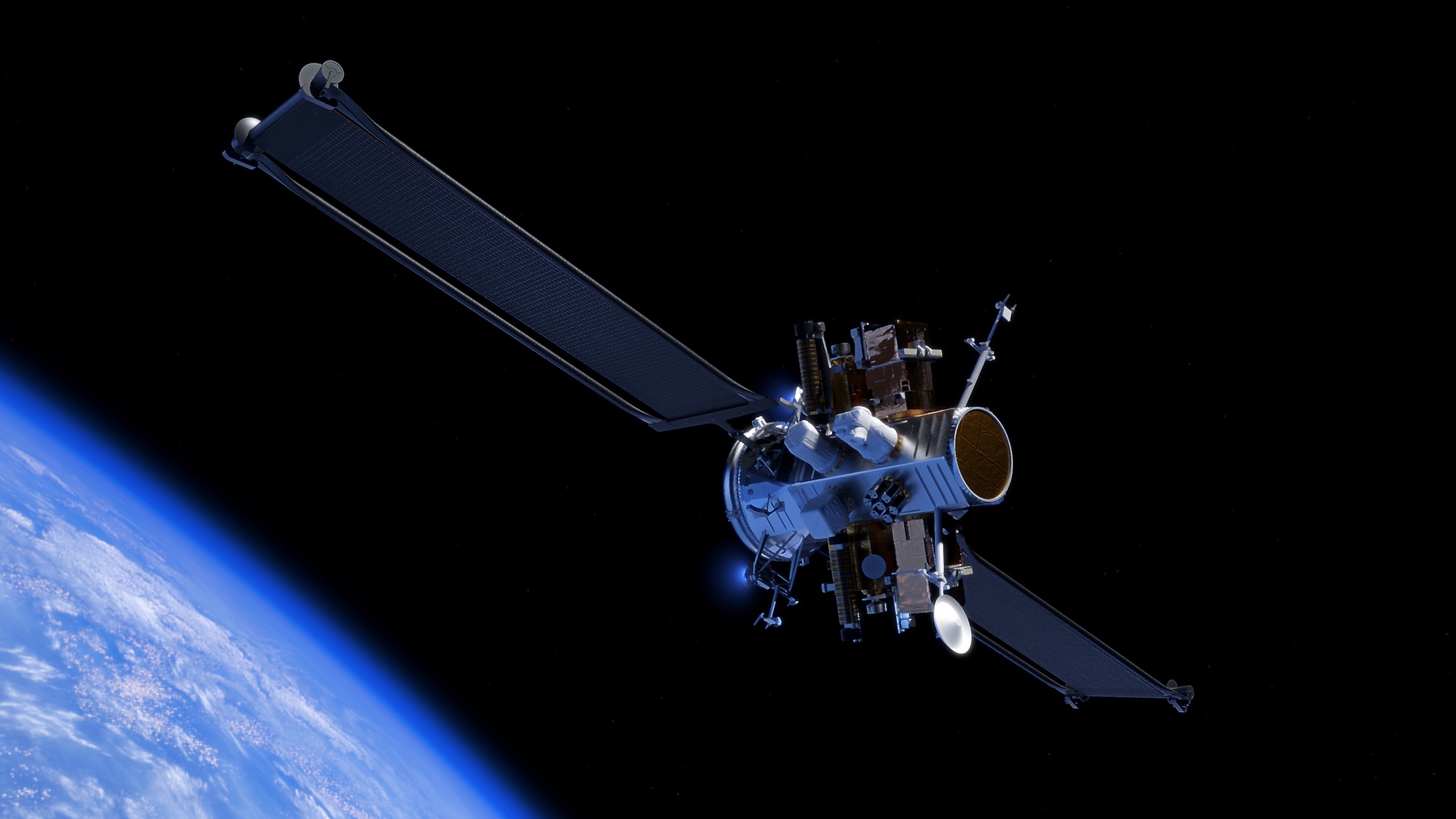
ORLANDO, Fla. — Blue Origin is highlighting the capabilities of an orbital transfer vehicle design it announced last year, including the ability of the spacecraft to serve as a fuel depot.
The company publicly announced last October its Blue Ring vehicle, which it described as providing a wide array of “in-space logistics and delivery” services from Earth orbit to cislunar space and beyond. The company had been hinting about development of a space tug for at least a year before the announcement.
That announcement provided few details about the technical capabilities of Blue Ring, but a company executive said there has been strong interest in the vehicle. “We’re bringing Blue Ring to market to do a lot of the missions that are starting to emerge from national security, civil and eventually commercial,” said Lars Hoffman, vice president of national security sales at Blue Origin, in a presentation at the SpaceCom conference here Feb. 1.
Blue Ring, he said, has 12 docking ports, each able to accommodate payloads weighing up to 500 kilograms. A top deck on the spacecraft can carry payloads weighing up to two and a half tons. The spacecraft offers 3,000 meters per second of delta V, or change in velocity, to maneuver to different orbits.
The “core mission” of Blue Ring is to deploy satellites in their desired orbits, but the spacecraft can also be used as a bus for hosted payloads. “We can serve as a very capable bus,” Hoffman said, with a design life of three to five years initially.
The ports on Blue Ring could be used to incorporate additional capabilities. One example he gave is robotic arms to support in-space servicing. “We absolutely see that as an extended capability.”
He added that Blue Ring is both refuelable and able to refuel other spacecraft, although he did not disclose the propellants the vehicle uses. “It can act as a refueling depot, if you will, where spacecraft can come up and plug in and fuel, or we can fly to a larger spacecraft and be the refueler of that spacecraft,” he said. “It’s quite possible for a Blue Ring to refuel a Blue Ring.”
“The flexibility of the vehicle is what really is its strength,” he argued. “It really is a multipurpose vehicle, and that’s the way we want to offer it.”
Blue Origin has not publicly disclosed any customers for Blue Ring or when the first vehicle will launch, but Hoffman said the company has been in talks with potential users, including during the conference. “We’d like to have more detailed discussions with potential customers. We had a lot at the conference this week.”
New Glenn and New Shepard updates
Blue Ring is the core of a new business unit at Blue Origin called In-Space Systems. The company, though, remains best known for its New Shepard suborbital vehicle and its New Glenn orbital launch vehicle under development.
Hoffman said the company continues to work towards a first launch of New Glenn later this year, but did not offer a more specific timeframe. Development of Launch Complex 36, which will host New Glenn launches at Cape Canaveral, is complete, he noted, and the company is working on ground tests of New Glenn hardware.
The company is also ramping up production of its BE-4 engines used both on New Glenn and United Launch Alliance’s Vulcan Centaur. Those engines “worked as advertised” on Vulcan’s inaugural launch Jan. 8, he said.
To help the company speed up production of BE-4 at a factory in Huntsville, Alabama, the company is using Marshall Space Flight Center’s Test Stand 4670, previously used to test engines for the Saturn 5 and Space Shuttle. The first BE-4 test from that stand took place Feb. 1, the company announced on social media. “That is going to help accelerate our delivery of those engines,” Hoffman said.
He also said the company will increase the flight rate of New Shepard. That vehicle performed a payload-only flight in December, the first since a launch mishap more than 15 months earlier. A crewed flight, the first since August 2022, will take place “very soon,” he said, but was not more specific.
Blue Origin has not disclosed how many New Shepard flights it plans for this year. “We are definitely getting back on track this year with New Shepard,” he said. “We want to get on a nice pace or rhythm here where we’re launching regularly, mostly astronaut flights but there will be payload flights mixed in there as well.”
He also echoed comments made by the company’s founder, Jeff Bezos, in December about speeding up the pace of activity at Blue Origin. “Blue gets dinged for moving slowly. I will say our pace is going to accelerate going forward,” he said. “But, taking that extra time up front is what leads to success on the first try.”
- SEO Powered Content & PR Distribution. Get Amplified Today.
- PlatoData.Network Vertical Generative Ai. Empower Yourself. Access Here.
- PlatoAiStream. Web3 Intelligence. Knowledge Amplified. Access Here.
- PlatoESG. Carbon, CleanTech, Energy, Environment, Solar, Waste Management. Access Here.
- PlatoHealth. Biotech and Clinical Trials Intelligence. Access Here.
- Source: https://spacenews.com/blue-origin-touts-capabilities-of-blue-ring-transfer-vehicle/
- :has
- :is
- :not
- :where
- $UP
- 000
- 1
- 12
- 15%
- 2022
- 36
- 5
- 500
- 8
- a
- ability
- Able
- About
- absolutely
- accelerate
- accommodate
- Act
- activity
- added
- Additional
- Alabama
- also
- Although
- an
- and
- announced
- Announcement
- any
- ARE
- argued
- arms
- Array
- AS
- astronaut
- At
- AUGUST
- back
- back on track
- BE
- been
- before
- BEST
- Beyond
- bezos
- Blue
- blue origin
- both
- Bringing
- bus
- business
- but
- by
- called
- CAN
- capabilities
- capability
- capable
- cape
- carry
- change
- civil
- come
- comments
- commercial
- company
- Company’s
- complete
- complex
- Conference
- continues
- Core
- could
- Customers
- December
- deck
- definitely
- delivery
- Delta
- deploy
- described
- Design
- desired
- detailed
- details
- Development
- DID
- different
- Disclose
- discussions
- do
- during
- each
- Earlier
- earth
- echoed
- emerge
- Engines
- eventually
- example
- executive
- extended
- extra
- factory
- Feb
- few
- First
- five
- fla
- Flexibility
- flight
- Flights
- For
- Forward
- founder
- from
- front
- Fuel
- gave
- get
- gets
- getting
- going
- Ground
- had
- Half
- Hardware
- Have
- he
- help
- here
- highlighting
- host
- hosted
- How
- HTTPS
- i
- if
- in
- Inaugural
- Including
- incorporate
- Increase
- initially
- interest
- IT
- ITS
- Jan
- jeff bezos
- jpg
- known
- larger
- Last
- Last Year
- later
- launch
- launches
- launching
- Leads
- least
- Life
- like
- logistics
- Lot
- made
- many
- Market
- missions
- mixed
- months
- more
- mostly
- moving
- National
- national security
- New
- nice
- noted
- october
- of
- offer
- Offers
- on
- ONE
- or
- Orbit
- Origin
- Other
- our
- Pace
- per
- Place
- plans
- plato
- Plato Data Intelligence
- PlatoData
- plug
- ports
- possible
- potential
- potential customers
- presentation
- president
- previously
- Production
- provided
- providing
- publicly
- quite
- ramping
- Rate
- really
- Refueling
- regularly
- remains
- rhythm
- Ring
- Said
- sales
- satellites
- Saturn
- say
- Second
- security
- see
- serve
- Services
- servicing
- since
- Slowly
- Social
- Soon
- Space
- spacecraft
- specific
- speed
- stand
- Starting
- strength
- strong
- success
- support
- Systems
- Take
- taking
- Talks
- Technical
- test
- tests
- than
- that
- The
- their
- There.
- this
- this week
- this year
- those
- though?
- three
- time
- timeframe
- to
- tons
- took
- top
- towards
- track
- transfer
- try
- two
- under
- unit
- United
- used
- users
- uses
- using
- vehicle
- VeloCity
- very
- vice
- Vice President
- vulcan
- want
- was
- Way..
- we
- week
- weighing
- WELL
- What
- when
- which
- wide
- will
- with
- Work
- working
- year
- years
- you
- zephyrnet

